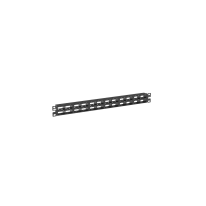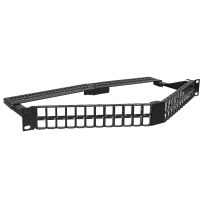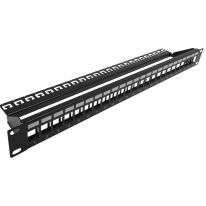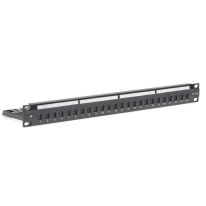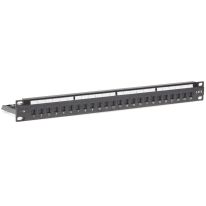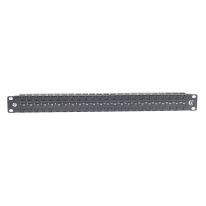Shop Server Rack Patch Panels
Consider your server rack as the heart of your networking set up. Without an organised and efficient infrastructure to manage your various services, switches and cables, your cabling equipment can easily become tangled, chaotic, and drop in performance quality.
Purchasing a server rack patch panel ensures your network stays robust, reliable and manageable.
At 4Cabling, our server rack patch panels facilitate 48 cables, offering a central hub to improve your ability to connect, disconnect, and troubleshoot your network. What’s more, they’re highly versatile and suitable for various network sizes and configurations.
We also understand that cable management isn't just about patch panels. That’s why we stock a range of cable management solutions, such as cable ties. They are effective for securing, bundling and organising your cables, ensuring that your server rack best practices are always in place.
Need some advice on what set up would work best for you? Fill in our contact us form on our website, and a member of the team will be in touch to help you find the right product and solution for your network.
FAQ
What is a server rack patch panel?
A server rack patch panel is a device that is used to connect cables from different devices in a server rack. In short, it simplifies the complexity of your network by offering a single point for all cable connections.
For instance, if you are housing servers, switches, routers and other equipment on your server rack, including a data patch panel reduces the chaotic tangle of cables. It reinforces a structured and manageable set up, and makes troubleshooting the network much easier.
How does a patch panel work?
In short, a patch panel rack acts as an intermediary between network devices, such as servers or switches, and network cables.
The front side of the patch panel features a series of ports or connectors, where you plug in your cables. Each individual port represents a specific connection point for a devices, whether that be a server or a switch.
On the back side of the rack patch panel is where you will find terminations or connectors that correspond to their respective front-end ports. These terminations are typically labelled or colour-coded so that you can easily identify which cable leads where.
Not only is it a connectivity hub. Patch panel cable management plays a critical role in organisation and maintenance.
What are the different types of server rack patch panels?
The two main types of data rack patch panel include copper and fibre optic.
Firstly, copper patch panels are designed to connect cables with copper conductors, such as Ethernet cables. They are commonly used for shorter distance connections within data centres or office networks.
On the other hand, fibre optic patch panels are engineered to handle cables with fibre optic conductors. They excel in transmitting data over longer distances and higher speeds, and are essential for applications requiring high bandwidth and data integrity. This could include connecting servers in separate buildings or transmitting data over longer distances.
What are the benefits of using a server rack patch panel?
Centralised Cable Management: Having an organised and central hub for your cable management means easier identification of connections and more streamlined maintenance overtime. For example, if you are experiencing connectivity issues, you can swiftly trace the problematic cause to its source using a patch panel.
Easier Troubleshooting: Labeling and organising your cables makes it easy to identify which cable is connected to where. This means that when issues arise, you can quickly isolate the problem, minimise downtime, and reduce the complexity of your network’s diagnostics.
Improved Airflow: Efficient cable management not only contributes to a tidier appearance but also enhances airflow within your server Ethernet rack panel, thus extending its lifespan. This is crucial for maintaining optimal operating temperatures for your equipment.
Reduced Clutter: Say goodbye to cable chaos and tangles. A patch panel setup minimises cable clutter, making your server rack a model of tidiness and professionalism. Neatly organized cables not only look impressive but also contribute to a safer and more efficient working environment.
How do I ensure proper cable management in a patch panel setup?
Consider these essential steps and practices:
Cable Organisers: Invest in cable organizers such as cable trays, management arms, and routing systems. These tools keep cables orderly and prevent them from becoming tangled or hanging loosely.
Group and Label Cables: Categorise cables based on their function, destination, or source device. Labeling each cable, or using color-coded tags, makes it easy to identify and trace connections.
Secure with Cable Ties and Velcro Straps: Use cable ties, velcro straps, or cable clips to bundle and secure cables neatly within the server rack.
Server racks and server patch panels are vital for an organised and efficient networking infrastructure. Consider how you can leverage our diverse range of products and cabling solutions to improve the performance of your network. If you have any questions about which set up would work best for you, contact us for expert advice and guidance. We’d be happy to help.




